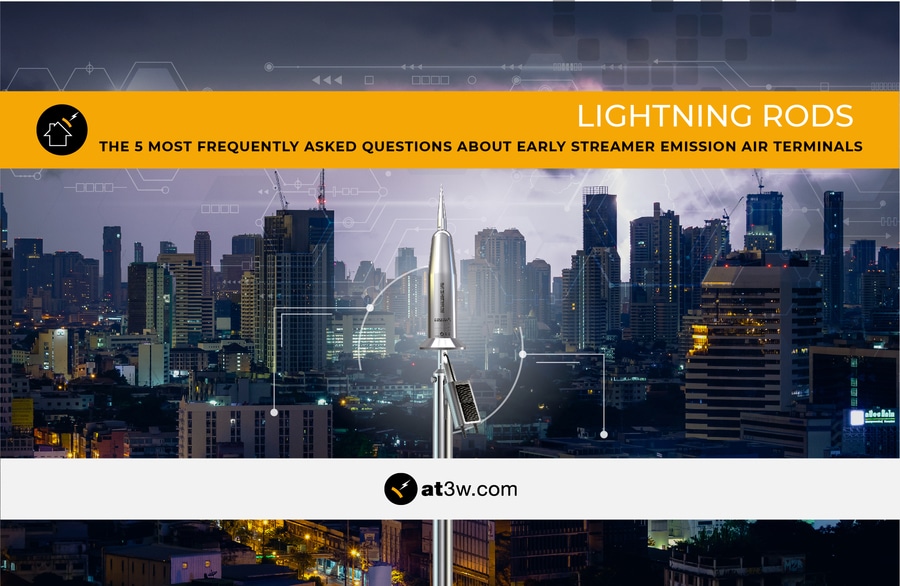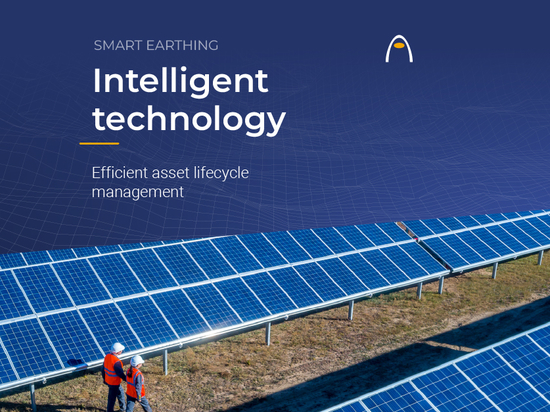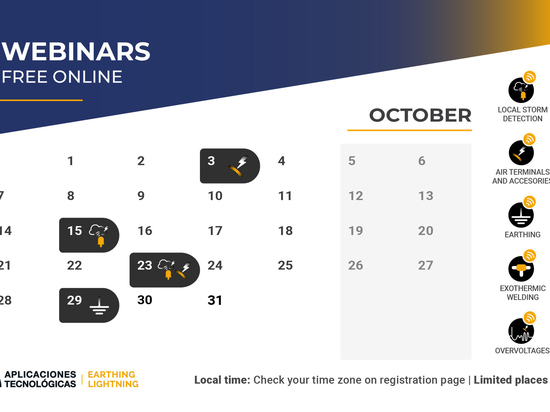
#Product Trends
The 5 most frequently asked questions about Early Streamer Emission (ESE) Air Terminals
The 5 most frequently asked questions about Early Streamer Emission (ESE) Air Terminals
A lightning strike is one of nature’s most destructive events. Early Streamer Emission (ESE) lightning arrester is one of the main tools in lightning protection systems (LPS), a major innovation over passive lightning rods or Franklin rods. Starting with its installation and requirements to functioning, these are the five most frequently answered questions about ESE in Aplicaciones Tecnológicas.
A lightning arrester with an Early Streamer Emission device, also known by its abbreviation (ESE) or under the name of ionizing lightning rod, is an active external lightning protection system. When it starts, a lightning bolt travels by a downward tracer which propagates in jumps in any direction. As it approaches the earth, it can strike any object. The purpose of any lightning arrester is to become the discharge point of the lightning strike, so that its impact is controlled and does not cause damage to people or infrastructure.
Unlike other lightning rods, the ESE device emits a continuous upward tracer with a time of advance, so that it anticipates the downward lightning strike and can catch it before it strikes any other object within its protection radius. It is this advance time that determines the radius of protection: the further the upward tracer emitted by the lightning rod is advanced, the greater the height at which it will capture the downward lightning tracer, and therefore the greater the protected lightning strike area.
With more than 35 years of experience in lightning protection systems, these are the most frequently asked questions about ESE Air Terminals answered by the specialists at Aplicaciones Tecnológicas:
How much radius can an ESE device protect?
The protection radius of an Early Streamer Emission depends on its advance time, the Protection Level of the structure it protects and its height above the point to be protected. The longest advance time that can be applied, according to the regulations, is 60 µs. Lightning rods with this time can protect more than 100 metres, although this always depends on the Protection Level and the height.
For all calculations there are 3 different height sections, both applying the UNE21186 standard and the CTE (Technical Building Code):
Between the tip and 2 metres below, the lightning rod is not considered to offer protection (arcing may occur, which would cause the discharge to be directed at the supposedly protected object)
Between 2 and 5 metres, the protection radius varies very sharply (in the order of tens of metres)
From 5 metres and above, the protection radius hardly changes.
The important thing is to protect the roof of the building (especially the corners) and all the elements on it. For this reason, Aplicaciones Tecnológicas recommends installing the lightning rod on a 6 metre mast, and characterises the protection radius of its lightning rods for this height in each Protection Level.
Can the down-conductor be in contact with the metal structure?
The standard (UNE21186) considers an isolated system to be one in which the lightning current is not in contact with the structure to be protected, not even at a distance at which a spark can be produced. In practice, this means that isolated systems are only those that are installed on a self-supporting mast or on an external element to the structure.
If the system is not isolated, the lightning current will be in contact with the structure, whether it is metallic or not. A cover for the conductor, a plastic tube or a clamp made of some insulating material is no impediment at all to the lightning current. Therefore, it is important to be aware that the current will be distributed throughout the metal structure. In fact, the regulations recommend this distribution, as it involves multiple paths for the discharge, minimising the current at each point and increasing the potential throughout the structure at the same time.
Can the down-conductor go through a downpipe?
The down-conductor of a lightning arrester should be as direct as possible and preferably installed on the external façade. The UNE21186 standard contemplates the possibility of the path through interiors, but only if it is not possible to do it through the exterior, as it involves verification and maintenance difficulties and involves a risk due to the penetration of the lightning current into the interior of the buildings. Maintaining separation distances and equipotential bonding can prevent sparks, but not surges.
However, if it is unavoidable that the down-conductor has to be routed inside the structure, the regulation specifies that it must be routed in a specific non-flammable, insulated conduit that runs in whole or in part inside the structure.
What is the spark gap used for and how is it installed?
The spark gap (also called isolation spark gap or ISG) is a component that electrically isolates different conductive parts of an installation using a discharge gap, which in the event of a lightning strike short-circuits and links these parts together. It is used to join elements that may cause problems if they are usually connected (e.g. corrosion) but must be joined together when the discharge occurs to avoid dangerous sparks. They are commonly used to bond the antenna mast and other metallic elements on the roof to the down-conductor, and also to bond the lightning arrester earthing to the general building earthing.
It must be installed in parallel with the down-conductor, never interrupting it, as this would separate the lightning arrester from the earthing, preventing it from working.
Should the LPS have a separate earthing system?
According to the UNE21186 standard, an earthing system must be installed for each down-conductor of the lightning arrester, with at least two electrodes and a resistance value of less than 10Ω. Three vertical electrodes are usually installed forming a triangle with sides equal to their length, as it has been proven that this is the shape that best and fastest dissipates the lightning current in the earth.
Also according to the standards, it is advisable that all the earthing systems of the building are connected. Normally, an insulated spark gap is used to connect the lightning arrester earthing to the general earthing, in order to avoid possible noise or corrosion problems.
In any case, the earthing system is an essential element of the lightning protection system and it is important that it is made directly downstream of the down-conductor.
DAT CONTROLER® REMOTE, a lightning rod with advanced technology
The DAT CONTROLER® Air Terminal of Aplicaciones Tecnológicas S.A. have the latest technology in Early Streamer Emission devices. In addition, within the Smart Earthing and Lightning Solutions range, the DAT CONTROLER® REMOTE smart lightning arrester has self-diagnosis of the rod head and communication via IoT of the result, to supervise the correct operation of the equipment remotely.
DAT CONTROLER® REMOTE forma parte de la gama Smart Lightning and Earthing Solutions, una línea que aplica tecnología inteligente de vanguardia y consigue la optimización completa de los SPCR mediante la integración de algoritmos y Big Data en los sistemas de control automatizados.
If you want to know more about Early Streamer Emission Air Terminals, you can contact us at this link.






